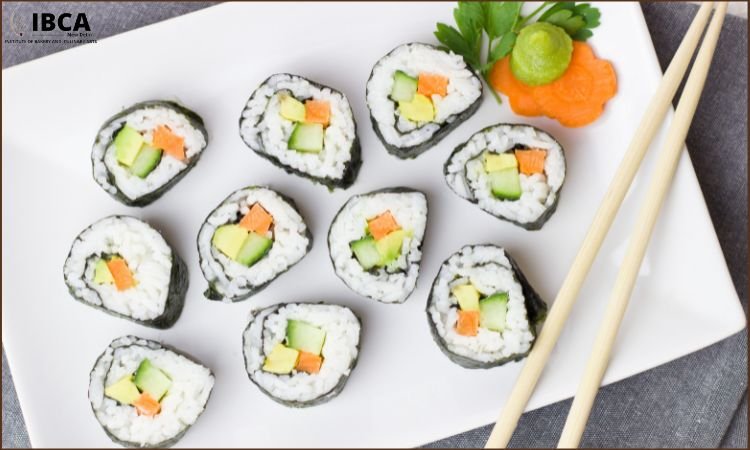From Sushi to Tsukemono: Your Ultimate Guide to Japanese Cooking Methods

One of the reasons Japanese is so loved around the world, too, is its refinement — delicate flavors and intricate artistry without resorting to or relying on sugar. Yet beyond the sushi rolls and ramen bowls, a bevy of cooking styles support these application traditions. So, whether you are a foodie or thinking of opting for culinary classes in Delhi this blog will be a quick guide from start-level Japanese cooking to the expert one.
Core Techniques of Japanese cooking
The base of Japanese cooking is formed by a solid set of principles that have been fine-tuned for hundreds if not thousands(!) If you can master these, I think Japanese cooking is the essence.
Simmering (Nimono)

Nimono: Simmered (Usually in a seasoned broth, often containing soy sauce, sake, and mirin) A method well suited to root vegetables, fish, and meat (whose porosity renders them sponges just waiting for flavor), while maintaining a high moisture content within. Nikujaga is a classic example of braised beef and potatoes.
Grilling (Yakimono)
When it comes to cooking methods or Yakimono,g rilling is another pillar of Japanese cuisine. Japanese grilling, on the other hand, seeks to warm things gently and mostly evenly rather than blisteringly hot with some grill marks. This restraint is displayed with dishes like Yakitori (charcoal-grilled chicken skewers) and Saba Shioyaki, a simple grilled mackerel finished only with salt.
Steaming (Mushimono)
Steaming (Mishimoto) – Steamed dishes, are a great way to keep the natural flavors and goodness of ingredients And for delicate, steamed dishes that are ultra-sensitive to timing and temperature (e.g., chawanmushi — a savory egg custard)? This in turn results in a light and flavorful dish that encapsulates the finesse of Japanese cuisine.
Deep-Frying (Agemono)
The concept of deep-frying or Agemono seems incongruous in a cuisine known for its lightness, but it is an essential part. Tempura employs Japanese deep-frying skills of frying and a lightly coating, flavorful batter. More importantly, you need to keep the oil temperature quite high so your food won’t taste oily and have a meaty texture.
Digging Deeper: Advanced Approach
So next, we move from the basics to some of those intermediate and advanced tricks that make Japanese cooking a veritable art form. These methods are artistic and require a great deal of precision to ingredients, although not necessarily less so than scientific cooking.
Sushi-Meshi (for Preparing Sushi Rice)

It all starts with the Sushi-Meshi: vinegared rice from nihongo-sushi.com The Sushi-Meshi is seasoned perfectly with a balance of rice vinegar, sugar, and salt making it an art on its own as well. Working the rice until it is al dente and still sticky, they scent warm seasonings into its granules before serving to guarantee that every bite sings with all their mingling flavors. Sushi-Meshi is truly made properly, but well glossy and each grain stands alone giving a slightly tangy background to the fresh fish or other ingredients.
Katsuobushi Dashi (bonito broth)
Katsuobushi Dashi is an umami bomb and the simple broth that underlies so much of Japanese cooking. Stock is made from dried bonito flakes (katsuobushi) and kombu (kelp), producing a very simple golden, clear soup. The method involves simmering kombu with water and steeped bonito flakes to produce their umami taste. As with a lot of cooking, learning to make dashi is key! Sosu (sauce) and nimono all start from here.
Tsukemono (Japanese Pickling)
When enjoying a meal, it is almost always accompanied by some Tsukemono (Japanese pickles) to heighten your tastebuds with a snap and burst of flavor. Japanese cuisine has a rich tradition of pickles, which can range from simple salt pickling to more complex fermentations. Two common methods include nukazuke, in which the pickles are laid down within rice bran, and shiozuke, where a saltwater or brine solution is used—smart cooking with high-quality ingredients. This kind of pickles can add to a meal and help digestion, as it is said that without tsukemono, the Japanese food culture would not be complete.
Conclusion
The methods that the guide you’re about to dive into are only a small percentage of potential know-how and technique in Japanese cooking. One that encompasses the harmony, meticulousness, and discipline around ingredients synonymous with Japanese culinary traditions. Whether you are using these techniques at home or getting a major from culinary courses in Delhi, even if going for a Diploma In Culinary Arts would be perfect it will enhance the standard of cooking as well as broaden your process know-how.
So, as you take new adventures into Japanese cuisine this week the joy is in the journey. From a humble simmered vegetable to an impressive cut of sushi where you prepare your filling ingredients, all are pathways to knowing the depth Japanese cuisine has in store as its cultural heritage.



